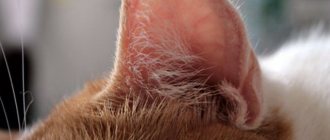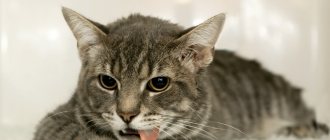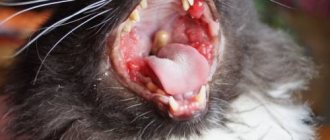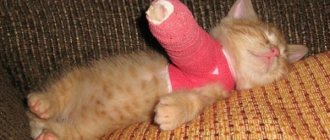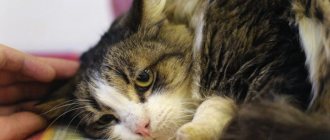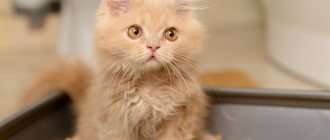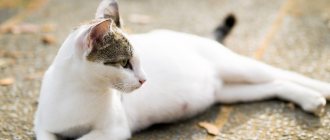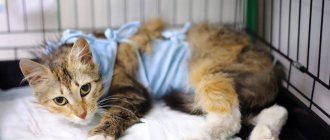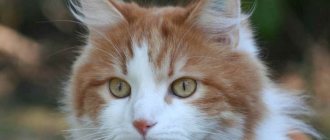Many people confuse vomiting with regurgitation (spitting up). Regurgitation is a passive action in which undigested food is expelled from the esophagus. The muscles of the esophagus contract, and the pet regurgitates undigested food, which is sometimes accompanied by liquid. For example, this happens when a cat eats grass.
Regurgitation is usually easily tolerated by animals and is not associated with severe abdominal contractions. Regurgitation occurs immediately or within two hours after eating. Vomiting is usually accompanied by convulsions. The vomit has a sour smell and may contain yellow fluid (bile mixed with digested food).
Difference between spitting up and vomiting
The cat's body's ability to break down toxins is limited. However, cats are different in that they themselves can cause vomiting and regurgitation. This mechanism is necessary to get rid of “dangerous” food.
Regurgitation
Often owners confuse regurgitation with vomiting. The difference is that the food that the cat regurgitates has not begun to be digested by gastric juice, since it has not yet entered the stomach.
To regurgitate, the cat takes a characteristic position: lowers its head, stretching it forward, the back of the body is raised, the front is lowered down and burps undigested food from the esophagus.
The cat burps immediately after eating or within 2 hours. The food comes out in oblong bars, similar to sausages. It occurs in white foam or mucus. If food remains in the esophagus for a long time, it may come out mixed with blood. This is usually red, bright blood.
Common causes of frequent regurgitation are narrowing or dilation of the esophagus.
Vomit
The rapid ejection of stomach contents (food, water, possibly bile) is vomiting. Often accompanied by nausea, salivation, and vomiting. Not only the stomach is involved in the process, but also the muscles of the abdominal wall and the diaphragm. Vomit has a sour smell. The food comes out partially digested. If blood is present, it is usually dark, the color of coffee grounds, as it begins to be digested.
Features
It is difficult to distinguish regurgitation from vomiting. Often these signs are present simultaneously.
| Signs | Regurgitation | Vomit |
| Contraction of abdominal muscles | — | + |
| Digested food | — | -/+ |
| Presence of saliva | + | Sometimes |
| Presence of gastric juice | — | + |
| Nausea | — | + |
The time after eating food may vary in both the first and second cases.
Situations when you should urgently contact a veterinarian
If a cat vomits only once, this does not indicate a serious illness. It is worth observing the condition of your pet during the day. The absence of lethargy and loss of appetite indicates that the animal is fine. You should seek veterinary help if your cat vomits food 2-3 times or more a day or single episodes are repeated daily.
Attention! A pet needs medical attention when attacks of nausea are accompanied by diarrhea, fever, and lethargy.
The color of the vomit can suggest the presence of certain diseases. For example, if a cat vomits white foam several times, this indicates a viral infection.
The presence of yellow bile in the contents of the stomach indicates problems with the liver and gall bladder. Mucous vomiting is most often a sign of infection with worms or an inflammatory process in the stomach or intestines.
Pregnant cats sometimes vomit
The greenish color of the masses indicates a bacterial infection. The most dangerous situation is when streaks or blood clots are found in the vomit. This indicates internal bleeding caused by a tumor or damage to the walls of the stomach, esophagus or larynx. Intestinal obstruction is indicated by the unpleasant smell of feces spreading from the vomit.
Attention! Life-threatening conditions accompanied by nausea, diarrhea, and general depression require immediate contact with a veterinary clinic.
Main reasons
The most common causes of food vomiting are related to diet and the presence of diseases of the gastrointestinal tract (GIT).
From a great love for food
Cats and cats are big food lovers. They cannot restrain themselves, especially if they are fed cheap food. These products contain many additives that improve taste. Overeating puts a lot of stress on the stomach, which ends in nausea and vomiting.
There is a separate category of pets that eat like their last every time. They quickly try to eat, swallowing food, and then they are tormented by belching. Regurgitation of undigested food occurs a few minutes after eating. In this case, you need to reduce the portions by 2-3 times, but feed more often. You can also consider interactive toys filled with dry food as an option. This is both a stimulator of hunting instincts and a device that will prevent the cat from eating too quickly.
Why does a pregnant woman vomit?
What to feed a cat after giving birth: proper nutrition and care
From time to time, a fatty herring fillet, mackerel, or at least sprat should appear in the bowl of a pregnant or lactating cat. If the cat vomits, the listed types of fish are replaced with others, for example, cod or trout. In addition, the future cat mother requires products to which she is instinctively drawn. This short list consists of:
- milk or, if the cat has toxicosis from milk, other products containing calcium;
- bone meal.
Breeders feed their pets 3 or 4 times a day. The volume of each serving does not exceed the dose that non-pregnant cats receive. Although the expectant mother needs to eat a lot, her small stomach cannot cope with a large amount of food, and excess food will come out in the form of vomiting.
It is not necessary to feed animals, including pregnant animals, only fresh foods. They can be replaced with dry or canned food.
A pregnant cat does not become gluttonous
If a pregnant cat vomits after eating undigested food, or if she refuses her favorite foods, the animal may feel that labor is approaching. This is not a reason to panic. You shouldn't force her to eat. All a future cat mother needs is peace and a comfortable bed. After giving birth, her appetite will return, and she will eat more than always. The size of the portions consumed by the mother in labor depends on the number of kittens.
Vomiting after eating in a cat or kitten sometimes signals the onset of an allergic reaction. If this is true, vomiting attacks will begin immediately after eating and will stop after adjusting the diet.
Important! Newborn kittens should not be overfed. Indicators of their health are their appearance and mood. Kids should look reasonably well-fed and cheerful. If the litter is large and there is not enough mother's milk, the kittens are fed with specialized food purchased at a pet store.
A cat may vomit after eating if the animal’s body is immune to certain types of food or its components. The cause of nausea may be eating food too quickly, swallowing too large pieces or large portions that the animal’s stomach is not able to handle.
When there is no danger
Vomiting is not considered dangerous in the following cases:
- The cat vomited after eating grass. A pet can immediately vomit this grass with white, almost transparent foam. There is no reason to worry.
- The cat is sick from overeating. The stomach is overloaded. Vomiting relieves him of unnecessary stress.
If the cat has no illnesses and vomits every few days, then there is no need to do anything. In a single case, if the pet is active and there are no other signs of illness, the best option is a starvation diet. The cat is left without food for a maximum of a day. You can give a tablespoon of natural meat broth after 4-6 hours, then after another 4 hours, or not feed it at all.
Treatment used
Of course, the owner is interested in what to do in such cases . Otherwise, no special measures even need to be taken. For example, if a cat vomited due to toxicosis, all that remains is to wait for it to pass. If regurgitation is the result of stress, then you will also have to wait until the animal adapts to its new conditions.
It happens that a person takes in a stray animal, tries to feed it, and the cat begins to regurgitate what it has eaten. In this case, you just need to establish the right diet. You need to feed your cat more often, but in small portions, so that all the food has time to be absorbed. Gradually, portions can be increased, even every day you can slightly adjust the diet in order to gradually get closer to the norm. In addition, dry food should be selected in accordance with the age of the animal and its state of health.
By the way, special foods are produced for animals with thick hair that help remove stuck hairs from the stomach. Then the animals will not even have anything to regurgitate. Especially if they don’t need to be groomed, and the owner makes it a rule to regularly comb their fur, removing loose hairs.
If an animal walks freely on the street, then, unfortunately, it will vomit quite often, since it is very difficult to make sure that it does not eat anything prohibited, does not grab some foreign object, and does not rummage through the garbage. It is on the street that it is easiest to pick up parasites. This also needs to be monitored. Helminthiasis should be treated with special medications. But green stalks of barley and wheat, which can be grown on a windowsill, also help cleanse the body.
If the cause of vomiting could be food poisoning, you need to provide the animal with the right diet. First, you need to starve the cat for some time and only drink water. When the vomiting stops, you need to give pieces of boiled chicken in small portions every two hours. You can buy your pet meat puree, which is produced for children. You cannot immediately increase the portions; you need to wait a few days. And for another week after this, you should give only what the body can digest well, without unnecessary effort.
Some experts believe that the treatment of poisoning in a cat should be the same as in humans, and it should be given an enterosorbent, for example, Enterosgel.
Vomiting as a dangerous symptom
Frequent or constant vomiting in cats after eating is a serious blow to health: fluid is lost from the body, the level of gastric juice decreases, appetite disappears, and there is a risk of dehydration.
If the cat vomits for more than 3 days in a row and several times a day, blood of any color from red to black is found in the vomit, the pet is lethargic, you need to consult a doctor as soon as possible. You should not put off a visit to the hospital even if vomiting food happens weekly, there is bile in the vomit, there was a nutritional adjustment, but the problem remained.
Vomiting in cats is a sign that there is a problem in the body, which can be serious or not very serious. The symptom cannot be ignored. And try to quickly find out the cause and help alleviate the pet’s condition.
Causes of vomiting in cats
Vomiting or reverse peristalsis, regurgitation is a normal process for a cat. If emptying the stomach through the mouth does not occur too often, does not cause deterioration in well-being, and is not accompanied by additional pathological signs, there is no need to worry.
However, repeated vomiting is a symptom of infectious, invasive and non-contagious diseases.
A cat spits up after eating: what to do?
The cause of vomiting is the presence of food in the gastrointestinal tract. Therefore, to stop vomiting, you need to eliminate the cause - that is, food. The cat is not fed for half a day, or better yet, for a day. But you shouldn’t get carried away, because after a two-day fast, the mechanism for extracting energy from fat depots turns on. Reserve nutrients rush to the liver and a dangerous disease develops - lipidosis.
You must show your will and not react to your pet’s extortion; even a small crumb of food causes reflex vomiting. If the animal reacts to drinking, it is removed, a veterinarian is called, and before his arrival, a saline solution is injected subcutaneously in unlimited quantities.
Be sure to read:
The cat does not eat, only drinks water and vomits, what to do: symptoms and treatment, what is sick and how to help.
The next day, the pet is given some easily digestible food in an amount of no more than 1/3 of the norm. They give him plenty of water and monitor his behavior. If no new vomiting follows, increase the portion, bringing it to normal.
During diet therapy, the use of dry granules is suspended and wet nutrition is used. It is not necessary to use Smecta or Enterosgel, however, sorbents will help normalize digestion.
Prevention
To avoid having to treat your cat for vomiting with undigested food, it is recommended to carefully monitor its diet. A cat vomits less often if it is fed high-quality and balanced food or natural food containing a small amount of fat. Avoid overeating, which can cause your cat to vomit undigested food. It is also important to do timely deworming and vaccination. If your cat has long hair, you should brush it. It is not recommended to give animals small toys that could cause them to choke.
In what cases is it necessary to see a doctor?
First of all, answer a few questions. What age is the cat? What is her health? Is there a chance she swallowed something? How long has the vomiting been observed (once, several weeks, etc.)? If you have reason to believe that the vomiting is the result of something serious, make an appointment with your veterinarian. The doctor will examine and diagnose the cause of vomiting and prescribe appropriate treatment.
Follow all veterinarian orders on time and in full.
The cat often burps: reasons
Regurgitation in cats is normal and occurs for the following reasons:
- Regurgitation of semi-digested food by a lactating cat occurs in order to accustom kittens to solid food.
- Toxicosis of pregnancy: occurs after two decades of gestation, when other signs have not yet appeared.
- Gluttony: wild ancestors did not have a successful hunt every day. Therefore, the animals ate for future use. But, too much food is worse than not enough. The same thing happens if the owners try to give dry food according to the norm. Or there are competitors in the apartment. The animal attacks the pellets and eats too quickly. He doesn’t have time to drink anything, dry food absorbs moisture from the gastric mucosa. The body expels dangerous food to prevent dehydration.
- Residual effects of drugs. If the animal is fed after surgery, it will vomit.
- Hungry vomiting occurs in the morning, when an animal that is accustomed to eating by the hour forgot to feed it on time. A white foamy mass appears.
- Motion sickness in transport after feeding. Pieces of food shake and irritate the walls of the stomach.
- Hairballs that a long-haired pet swallows while licking can mix with food, form trichobezoars and block the intestinal lumen. To prevent this from happening, the cat begins to cough, vomit and regurgitate dangerous lumps.
- Soured or moldy food. With improper or prolonged feeding, peroxides are formed, which the body perceives as poisons and tries to get rid of them in every possible way. An opened bag of dry food can be stored for 40 days, and a can in the refrigerator can be stored for 36 hours.
- An excess of cereals or bread with a lack of meat and vegetables is perceived by the body as spoiled food.
- Foreign object: if it comes out, vomiting stops. Otherwise, urgent veterinary attention is required.
Be sure to read:
A cat vomits hair: reasons, what to do, medications and folk remedies, prevention
